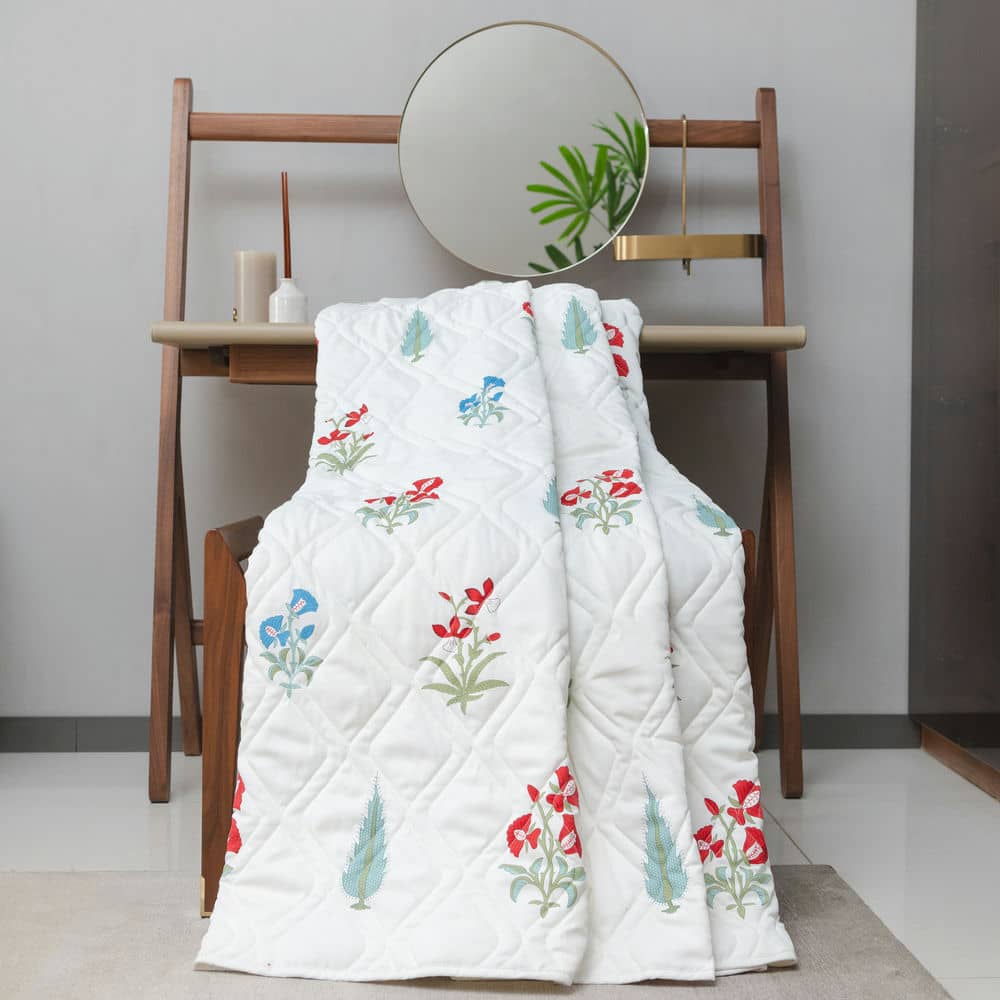Choosing the Right Bedsheet for Your Bedroom

Selecting the perfect bedsheet for your bedroom is more than just picking a pretty pattern. The right bedsheet can significantly enhance your comfort, improve your sleep quality, and elevate your bedroom’s aesthetic. Here's a comprehensive guide to help you choose the perfect bedsheet.
-
Material Matters
The material of your bed sheet is crucial for comfort and durability. Here are some popular options:

a. Cotton:
- Pros: Breathable, soft, durable, and easy to care for.
- Cons: Can wrinkle easily and might shrink after washing.
- Types: Egyptian cotton (luxurious and durable), Pima cotton (soft and durable), Upland cotton (more common and affordable).
Linen:
b. Linen:
- Pros: Breathable, moisture-wicking, and becomes softer with each wash.
- Cons: Can be expensive and wrinkles easily.
- Best for: Hot climates due to its cool and airy texture.
c. Polyester:
- Pros: Durable, wrinkle-resistant, and affordable.
- Cons: Less breathable, can feel less soft compared to natural fibers.
- Best for: Budget-friendly and low-maintenance options.
d. Bamboo:
- Pros: Eco-friendly, soft, breathable, and moisture-wicking.
- Cons: Can be expensive.
- Best for: Eco-conscious buyers and those with sensitive skin.
e. Silk:
- Pros: Luxurious, smooth, and hypoallergenic.
- Cons: Expensive and requires delicate care.
- Best for: A luxurious feel and skin benefits.
-
Thread Count and Weave

Thread Count:
- Refers to the number of threads per square inch of fabric.
- Higher thread count often means softer and more durable fabric, but it's not the only factor.
- Ideal range: 200-800 for most needs. Be wary of excessively high thread counts as they can sometimes be misleading.
Weave Types:
- Percale: Crisp and cool, with a matte finish. Ideal for those who prefer a lightweight and breathable sheet.
- Sateen: Smooth, lustrous, and warmer than percale. Great for a more luxurious feel.
- Twill: Durable with a diagonal weave, often found in flannel sheets. Good for colder climates.
-
Fit and Size

Proper fit ensures comfort and maintains the aesthetic of a well-made bed. Measure your mattress before purchasing.
Common Sizes:
- Twin: 39 x 75 inches
- Full: 54 x 75 inches
- Queen: 60 x 80 inches
- King: 76 x 80 inches
- California King: 72 x 84 inches
Depth Matters:
- Standard mattresses: 7-14 inches deep.
- Deep pocket mattresses: 15-22 inches deep.
- Ensure the fitted sheet can accommodate your mattress depth.
Read More: Finding the Perfect Fit: A Guide to Different Bed Sheet Sizes
-
Color and Design

The design and color of your bedsheet can set the tone for your bedroom.
Color Psychology:
- White: Classic, clean, and versatile.
- Blue: Calming and serene, promoting relaxation.
- Green: Refreshing and restful, connecting with nature.
- Gray: Neutral and modern, pairs well with various decors.
- Bold colors and patterns: Add a splash of personality and vibrancy.
Patterns:
- Solid colors offer versatility and a clean look.
- Patterns (stripes, florals, geometric) can add visual interest and match different decor styles.
-
Season and Climate Considerations

Your local climate and the season can affect your choice.
Warm Climates:
- Light, breathable fabrics like cotton and linen.
- Light colors reflect heat and keep you cool.
Cold Climates:
- Warm, insulating fabrics like flannel and heavier weaves.
- Darker colors can add warmth to the room.
All-Season:
- Mid-weight cotton or bamboo sheets that balance warmth and breathability.
-
Care and Maintenance

Easy-to-care-for sheets can save time and effort.
Cotton and Polyester:
- Generally machine washable and dryer friendly.
- Look for wrinkle-resistant finishes for easier maintenance.
Linen and Silk:
- Often requires more delicate care, such as hand washing or dry cleaning.
- Follow the manufacturer's care instructions closely.
-
Budget

Bedsheet prices can vary widely based on material, brand, and quality.
Budget-Friendly:
- Polyester and poly-cotton blends offer affordability and easy maintenance.
- Mid-range cotton sheets (like Upland cotton) balance quality and cost.
Luxury:
- Egyptian cotton, linen, and silk sheets are more expensive but offer superior comfort and durability.
- Consider investing in a few high-quality sets for a luxurious sleeping experience.
-
Eco-Friendly Options

For those who prioritize sustainability:
Organic Cotton:
- Grown without harmful pesticides and chemicals.
- Certified by organizations like GOTS (Global Organic Textile Standard).
Bamboo:
- A sustainable crop that requires less water and pesticides.
- Look for bamboo sheets that are OEKO-TEX certified to ensure they are free from harmful substances.
-
Brand and Reviews

Trusted brands often provide better quality and customer service. Look for brands known for their quality, such as:
- Bombay Dyeing
- Spaces
- Urban Space
- D’decor
Reading customer reviews can provide insight into the real-world performance and comfort of the sheets.
Conclusion
Choosing the right bedsheet involves considering material, thread count, weave, fit, color, seasonality, care, budget, and eco-friendliness. By balancing these factors, you can find the perfect bedsheet that enhances your bedroom's comfort and aesthetic. Remember, a good bedsheet is an investment in your sleep quality and overall well-being.
